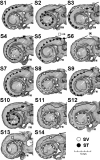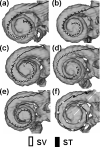Role of electrode placement as a contributor to variability in cochlear implant outcomes
- PMID: 18667935
- PMCID: PMC2663852
- DOI: 10.1097/MAO.0b013e318184f492
Role of electrode placement as a contributor to variability in cochlear implant outcomes
Abstract
Hypothesis: Suboptimal cochlear implant (CI) electrode array placement may reduce presentation of coded information to the central nervous system and, consequently, limit speech recognition.
Background: Generally, mean speech reception scores for CI recipients are similar across different CI systems, yet large outcome variation is observed among recipients implanted with the same device. These observations suggest significant recipient-dependent factors influence speech reception performance. This study examines electrode array insertion depth and scalar placement as recipient-dependent factors affecting outcome.
Methods: Scalar location and depth of insertion of intracochlear electrodes were measured in 14 patients implanted with Advanced Bionics electrode arrays and whose word recognition scores varied broadly. Electrode position was measured using computed tomographic images of the cochlea and correlated with stable monosyllabic word recognition scores.
Results: Electrode placement, primarily in terms of depth of insertion and scala tympani versus scala vestibuli location, varies widely across subjects. Lower outcome scores are associated with greater insertion depth and greater number of contacts being located in scala vestibuli. Three patterns of scalar placement are observed suggesting variability in insertion dynamics arising from surgical technique.
Conclusion: A significant portion of variability in word recognition scores across a broad range of performance levels of CI subjects is explained by variability in scalar location and insertion depth of the electrode array. We suggest that this variability in electrode placement can be reduced and average speech reception improved by better selection of cochleostomy sites, revised insertion approaches, and control of insertion depth during surgical placement of the array.
Figures




References
-
- Firszt JB, Holden LK, Skinner MW, et al. Recognition of speech presented at soft to loud levels by adult cochlear implant recipients of three cochlear implant systems. Ear Hear. 2004;25:375–87. - PubMed
-
- Blamey P, Arndt P, Bergeron F, et al. Factors affecting auditory performance of postlinguistically deaf adults using cochlear implants. Audiol Neurootol. 1996;1:293–306. - PubMed
-
- Rubinstein JT, Parkinson WS, Tyler RS, et al. Residual speech recognition and cochlear implant performance: effects of implantation criteria. The American journal of otology. 1999;20:445–52. - PubMed
-
- Friedland DR, Venick HS, Niparko JK. Choice of ear for cochlear implantation: the effect of history and residual hearing on predicted postoperative performance. Otol Neurotol. 2003;24:582–9. - PubMed
-
- Dawson PW, Blamey PJ, Rowland LC, et al. Cochlear implants in children, adolescents, and prelinguistically deafened adults: speech perception. J Speech Hear Res. 1992;35:401–17. - PubMed
Publication types
MeSH terms
Grants and funding
LinkOut - more resources
Full Text Sources
Other Literature Sources
Medical

